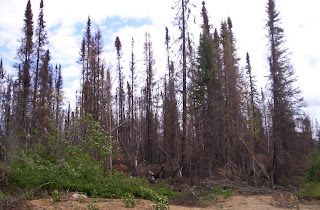Crews were able to get in with machines and make a fire break and likely back-fire to save a lot of our local forest in the Black Sturgeon area circa 2005.
 |
| Looking west away from the fire area. 2006 |
 |
| Looking north from the road. New growth showing green. |
 |
| The fire side of the break. |
 |
| Nature's fire break. It jumped the road but ran out of dry fuel in short order. |
 |
| The trees will stand like this for quite a few years. |
 |
| Grass, wildflowers and shrubs are starting to colonize the edges. |
 |
| Pale Corydalis, a gift of the Ice Age glaciation movement. |
A lot of our Northern Ontario Forest fires are caused by lightning.
Insect infestations provide a lot of "fuel-wood" for wildfires.
Let's look at what the Spruce Budworm has done. A write up in The Equipment Connection, Volume 4 No. 2 May 1980, page 11: credit Lakehead Printing and Stenographic Services Limited Thunder Bay Ontario.
The Canadian Forest Service predicts a decline in tree damage by spruce budworm this year. In 1979, 90 million acres ( 36.43 million hectares) of forest in Ontario and east into Maine, suffered moderate to severe defoliation, whereas, 80.9 million acres ( 32.75 million hectares) are expected to be infested this year in the same regions.
Meanwhile, the acreage of dead or dying timber has increased to 44.6 million acres (18.05 million hectares)from 21 million (8.5 million hectares) in 1977.
Best results in combatting the insect were reported in Quebec , last year. There, only 11.7 million acres ( 4.7 million hectares) suffered defoliation while 45.5 million acres ( 18.42 million hectares) were hit in Ontario. New Brunswick reported 3.3 million acres (1.3 million hectares) ; 71,000 acres (28,744.9 hectares) in Prince Edward Island; 2.4 million acres ( .97 million hectares) in Newfoundland; 4.5 million ( 1.82 milllion hectares) in Maine; and 150,000 acres (60,728 hectares) each in Minnesota, Wisconsin and Michigan.
Ontario, Nova Scotia and Newfoundland are expected to have the greatest problems this year, said the C.F.S.
"The budworm has eliminated most of the balsam in eastern Ontario," said Thunder Bay Regional Forester Jack Flowers, recently. "We have two outbreaks west of here. One is just west of the city, and the other's in Fort Francis. But the balsam is all dead east of Wawa. It's just standing there grey, and its a perfect fire hazard."
The Ministry (of Natural Resources ) last sprayed for budworm in 1968, says Mr. Flowers, because environmental restrictions have prohibited the use of insecticides since the 1970's.


No comments:
Post a Comment